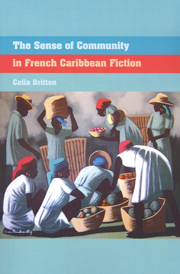Book contents
- Frontmatter
- Contents
- Acknowledgements
- Abbreviations
- Introduction
- 1 Restoring Lost Unity in Jacques Roumain's Gouverneurs de la rosée
- 2 Past, Future and the Maroon Community in Edouard Glissant's Le Quatrième Siècle
- 3 Living by Mistake: Individual and Community in Simone Schwarz-Bart's Pluie et vent sur Télumée Miracle
- 4 Singular Beings and Political Disorganization in Vincent Placoly's L'Eau-de-mort guildive
- 5 Conquering the Town: Stories and Myth in Patrick Chamoiseau's Texaco
- 6 Community, Nature and Solitude in Daniel Maximin's L'Ile et une nuit
- 7 On Not Belonging: Surrogate Families and Marginalized Communities in Maryse Condé's Desirada
- Conclusion
- Notes
- Bibliography
- Index
6 - Community, Nature and Solitude in Daniel Maximin's L'Ile et une nuit
- Frontmatter
- Contents
- Acknowledgements
- Abbreviations
- Introduction
- 1 Restoring Lost Unity in Jacques Roumain's Gouverneurs de la rosée
- 2 Past, Future and the Maroon Community in Edouard Glissant's Le Quatrième Siècle
- 3 Living by Mistake: Individual and Community in Simone Schwarz-Bart's Pluie et vent sur Télumée Miracle
- 4 Singular Beings and Political Disorganization in Vincent Placoly's L'Eau-de-mort guildive
- 5 Conquering the Town: Stories and Myth in Patrick Chamoiseau's Texaco
- 6 Community, Nature and Solitude in Daniel Maximin's L'Ile et une nuit
- 7 On Not Belonging: Surrogate Families and Marginalized Communities in Maryse Condé's Desirada
- Conclusion
- Notes
- Bibliography
- Index
Summary
Daniel Maximin has written three novels, the so-called ‘Caribbean trilogy’ consisting of L'Isolé soleil, Soufrières, and L'Ile et une nuit; they are all set in Guadeloupe, and many of the same characters appear in all three. The main focus of this chapter will be on L'Ile et une nuit, but I shall also refer quite extensively to Soufrières, because these two novels also have in common the central theme of natural disaster. Soufrières is the name of the volcano that was thought to be about to erupt in 1976, while L'Ile et une nuit recounts the ‘one night’ in which Hurricane Hugo hit the island in 1989. In both texts, therefore, the community of Guadeloupe is defined in relation to the forces of nature, and by its capacity to resist them. As the blurb introducing Soufrières puts it, ‘Tout un peuple habitué des apocalypses de l'histoire et de la géographie se prépare la résistance’; and on the last page of L'Ile et une nuit Marie-Gabriel ‘entendait déjà sourdre la résistance de l'île au travail sous le masque du désastre en cours’ (p. 172).
These kinds of extreme natural phenomena lend themselves readily to allegorical use; in particular, the volcano has a long history in Caribbean literature as a metaphor for social unrest and revolution. Most critical work on Maximin's writing has followed this trend: thus, for instance, Chris Bongie equates the volcano of Soufrières with the modernist anticolonial revolution that never happens, and Nick Nesbitt interprets the hurricane in L'Ile et une nuit as a depoliticizing metaphor for the colonization process.
- Type
- Chapter
- Information
- The Sense of Community in French Caribbean Fiction , pp. 111 - 130Publisher: Liverpool University PressPrint publication year: 2010



